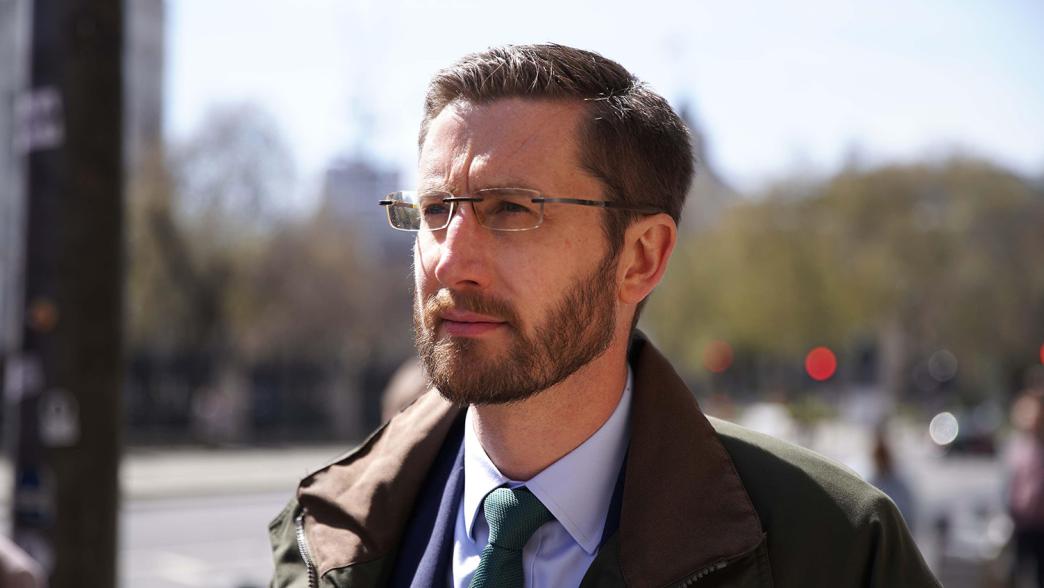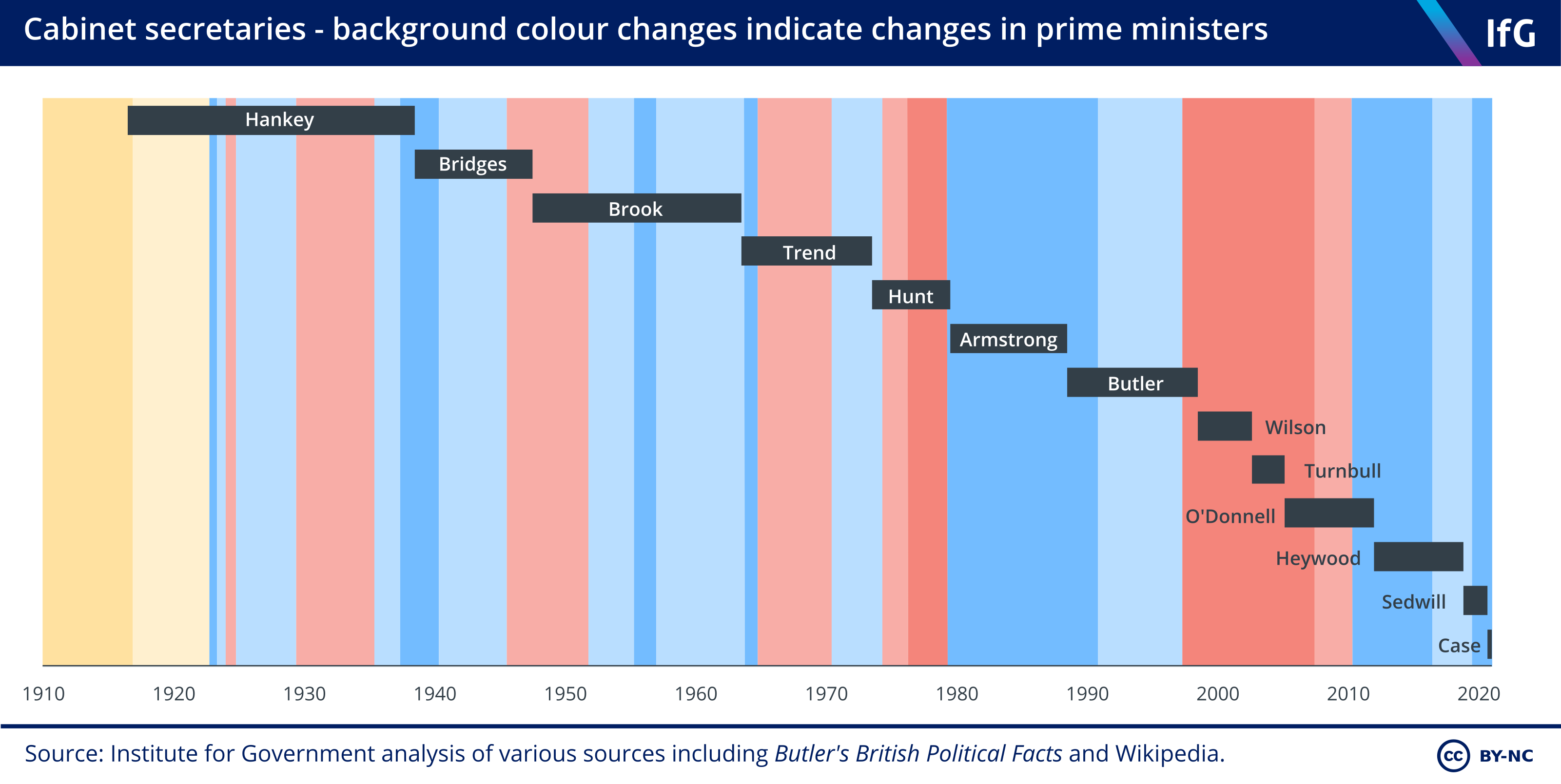Cabinet secretary
The cabinet secretary is the most senior civil service adviser to the prime minister and cabinet.

What is the cabinet secretary?
The cabinet secretary is the most senior civil service adviser to the prime minister and cabinet. Their formal role is to support and advise on the running of cabinet and cabinet committees and to support the government in reaching a collective agreement on policies. They often act as one of the prime minister’s senior advisers on the working of government and on major policy decisions. They also work very closely with the most senior ministers in government, advising the prime minister on priority issues and ensuring that the rest of the civil service works to deliver those priorities.
The relationship between the prime minister and cabinet secretary, and how they decide to work together, makes a big difference to the cabinet secretary’s influence. 12 Cabinet Office and Prime Minister's Office,10 Downing Street, Simon Case appointed as Cabinet Secretary and Head of the Civil Service, press release, 1 September 2020, www.gov.uk/government/news/simon-case-appointed-as-cabinet-secretary-and-head-of-the-civil-service The role of cabinet secretary is the most senior in the civil service. It is usually the post-holder’s last within the civil service, though Edward Bridges, who was cabinet secretary during the Second World War, stayed on to become permanent secretary to the Treasury for 10 years.
Who is the current cabinet secretary?
The current cabinet secretary is Simon Case, replacing Sir Mark Sedwill who stepped down in September 2020. Case was previously the private secretary to the Duke of Cambridge and was the permanent secretary at Number 10.
Like Sedwill, Simon Case has not held a major economic or Treasury role, unlike many previous cabinet secretaries. Unlike Sedwill, he has not run a department himself or taken the lead on a major project. However, he does have significant experience at the centre of government as the principal private secretary to David Cameron and Theresa May, and as head of Cameron’s implementation unit in the Cabinet Office.

What does the cabinet secretary do?
The modern cabinet secretary has to cover a number of different functions. In 2015 former cabinet secretary Sir Jeremy Heywood identified eight roles:
- Secretary to the cabinet
This role involves helping prepare the agenda and papers for cabinet and cabinet committees, supporting ministerial chairs with the process of collective decision making. They are supported in this role by the cabinet secretariat in the Cabinet Office. Departments or the centre propose items for discussion, but the prime minister ultimately decides the agenda for cabinet. The cabinet secretary and their team prepare the papers, minute the discussion, decisions and agreements. The cabinet secretary oversees cross-Whitehall correspondence and papers where decisions need collective agreement. - Adviser to the prime minister
The cabinet secretary, supported by the cabinet secretariat, advises on the prime minister’s policies and ways of governing. No 10 and the prime minister seek advice on a wide range of issues, especially when they require co-ordination from the centre. - Guardian of propriety and ethics
The prime minister can, if he or she chooses, call on the cabinet secretary to advise on adherence to the Ministerial Code, which governs the actions of ministers. For example, in 2019 Sir Mark Sedwill investigated a leak from the National Security Council, leading prime minister Theresa May to demand the resignation of defence secretary Gavin Williamson. - Driving implementation
The cabinet secretary ensures that the civil service is acting to deliver key manifesto commitments and policies. They help broker decisions between cabinet ministers and departments, and then ensure that these decisions are followed through.
Many cabinet secretaries, including Heywood, Sedwill and now Simon Case, have also been head of the civil service, which involves:
- Leading the civil service
The cabinet secretary oversees all civil servants and convenes regular meetings of the departmental permanent secretaries. Their leadership has historically been only of the ‘home’ civil service (excluding the Foreign and Commonwealth Office). - Managing senior civil servants
The cabinet secretary has significant influence in recruiting permanent secretaries, and line manages many of them. They help set their objectives and collect and deliver feedback (now focused around Single Departmental Plans). Cabinet secretaries also influence where to reward good performance with bonuses and whether to re-assign, move or dismiss a permanent secretary. - Leading reform and improvement of civil service
The cabinet secretary can choose to pursue a reform agenda for the civil service, in line with the government’s plans and to ensure that the organisation is fit to deal with the challenges it faces. This includes making sure that the civil service runs efficiently and has the right skills and expertise. - Representing the civil service externally
As its head, the cabinet secretary explains, promotes and sometimes defends the civil service to the public. They appear at parliamentary select committees, sometimes talk to the media and are active on social media.
Is the role of cabinet secretary always combined with head of the civil service?
Often, but not always. After Sir Gus O’Donnell stepped down as cabinet secretary in 2011 his role was split, with Sir Bob Kerslake becoming the separate head of the civil service, and Sir Jeremy Heywood succeeding as cabinet secretary. However, Heywood took over from Kerslake in 2014, again combining the two posts. The cabinet secretary is supported in this position by the chief executive of the civil service or, from 2020, a chief operating officer, currently Sir Alex Chisholm.
Can cabinet secretaries hold other civil service positions?
Yes, former cabinet secretary Sir Mark Sedwill was also the national security adviser.
Sedwill kept this role when he became cabinet secretary. Although he argued the roles were complementary, and many of his predecessors combined the functions, Sedwill was criticised for holding three demanding roles – cabinet secretary, head of the civil service and national security adviser – at the same time. 16 Sir Mark Sedwill, Cabinet Secretary and Head of the Civil Service, Civil Service Quarterly, 13 February 2020, quarterly.blog.gov.uk/2020/02/13/the-csq-interview-sir-mark-sedwill-cabinet-secretary-and-head-of-the-civil-service/ Simon Case does not hold the role of national security adviser.
Former cabinet secretaries during the Cold War were also senior advisers on intelligence matters and on nuclear war planning. It was only in 2002 that the role of intelligence and security co-ordinator was made distinct from the cabinet secretary. 17 241, The Cabinet Office and the Centre of Government, Lords Constitution Committee, 6 January 2010, www.publications.parliament.uk/pa/ld200910/ldselect/ldconst/30/3006.htm#a28 The cabinet secretary is also the accounting officer for the Single Intelligence Account, the funding of the UK’s three main intelligence agencies.
How is the cabinet secretary appointed?
There is no standard process for appointing a cabinet secretary. Many former cabinet secretaries were appointed directly by the prime minister, sometimes on the recommendation of the outgoing cabinet secretary. In recent years, some cabinet secretary appointments have involved a slightly more formal process with the prime minister interviewing a range of candidates.
The appointment process is overseen by the first civil service commissioner, who is responsible for regulating civil service recruitment. As with any other civil service position, the cabinet secretary’s appointment must be ‘on merit on the basis of fair and open competition’ according to the 2010 Constitutional Reform and Governance Act, and should not be a political appointment.
The then first civil service commissioner (Ian Watmore) led a competition to appoint a new cabinet secretary after Sedwill stood down, inviting existing or former permanent secretaries to apply for the role. Reporting at the time suggested that Simon Case did not apply, but was asked to take on the job directly by the prime minister.
How much is the cabinet secretary paid?
As of September 2020, the cabinet secretary was paid between £200,000 and £204,999, which was the fifth highest paid civil service role in the Cabinet Office. 18 Cabinet Office, Senior officials 'high earners' salaries as at 30 September 2020, www.gov.uk/government/publications/senior-officials-high-earners-salaries
How is the cabinet secretary held accountable?
Under the principle of ministerial accountability, it is government ministers who are accountable to parliament for the actions of the government, including the officials working for them. As such, the cabinet secretary is effectively held to account via the ministers they work for, primarily the prime minister who is also Minister for the Civil Service.
But like other senior officials, the cabinet secretary does appear before parliamentary select committees in their own right to answer questions on their work. The Public Administration and Constitutional Affairs Committee (PACAC) has questioned Sir Mark Sedwill and his predecessor, Sir Jeremy Heywood, a number of times in recent years, on topics including Brexit preparations, the effectiveness of the civil service and the role of the cabinet secretary.
The government’s Lead Non-Executive Director is responsible for the annual appraisal of the cabinet secretary. They gather and deliver feedback from ministers and senior civil servants that work alongside the cabinet secretary.
Can ministers fire the cabinet secretary?
Ministers are not generally able to fire civil servants. This principle is to protect the impartiality of the civil service, though ministers have at times complained that this undermines their control over departments and too easily protects poor performance.
However, without the confidence of the prime minister a cabinet secretary would find their position untenable. When relationships have broken down in the past, differences have usually played out in private, though both Richard Wilson as cabinet secretary and Sir Bob Kerslake as head of the home civil service found themselves subject to negative briefings in the media. No cabinet secretary has ever been publicly forced from their role, though some of them have been privately encouraged to step down.
What happens if the cabinet secretary is absent from the role?
There is no formal constitutional process if a cabinet secretary is temporarily absent from the role. Although Helen MacNamara held the position ‘deputy cabinet secretary’ from Spring 2020 to February 2021, there is not normally an automatic deputy to the cabinet secretary.
In 2018 Sir Jeremy Heywood stepped down on grounds of ill health and Sir Mark Sedwill took the job temporarily, before being confirmed in post in 2019. In October 2023, it was announced that Simon Case would be taking a leave of absence as a result of ill-health. His duties as cabinet secretary and as head of the civil service would otherwise be carried out by Sir Alex Chisholm, Cabinet Office permanent secretary and civil service chief operating office, and Sir Chris Wormald, permanent secretary at the Department of Health and Social Care and the longest-serving departmental permanent secretary. 20 UK's top civil servant takes medical leave, BBC News, www.bbc.co.uk/news/uk-politics-67189907
While others can undertake the duties of the cabinet secretary – acting as secretary for cabinet, advising the prime minister on policy, government and proprietary or constitutional matters – the seniority and status of the cabinet secretary is fundamental to the role functioning well. It matters both constitutionally and to the functioning of government that the role not be vacant for long periods of time.
- Topic
- Civil service
- Keywords
- Civil servants
- Publisher
- Institute for Government